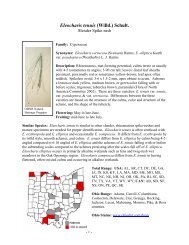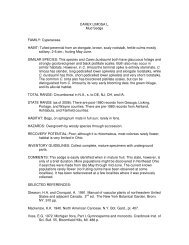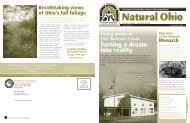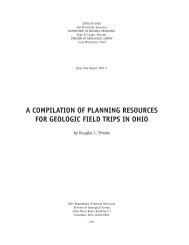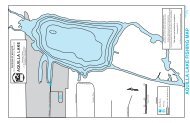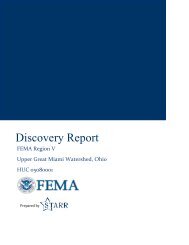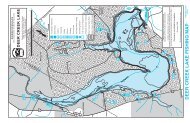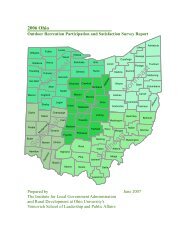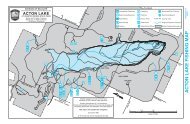Great Lakes Restoration Project - Ohio Department of Natural ...
Great Lakes Restoration Project - Ohio Department of Natural ...
Great Lakes Restoration Project - Ohio Department of Natural ...
- No tags were found...
You also want an ePaper? Increase the reach of your titles
YUMPU automatically turns print PDFs into web optimized ePapers that Google loves.
Restoring Minnesota’s Lake Superior CoastCaring for streams and their watershedsMinnesotans recognize that the health <strong>of</strong> Lake Superior depends onthe quality <strong>of</strong> the water that flows from its watershed.Storm water, wastewater and trash in contact with streams all threatenthe health <strong>of</strong> Lake Superior by carrying garbage, excessive sedimentand other pollutants. In 2001, Minnesota’s Lake Superior CoastalProgram worked with a variety <strong>of</strong> natural resource managers toleverage a federal commitment <strong>of</strong> restoration funds to protect andrestore Lake Superior streams and shorelines.Managing Storm Water. Streams dominated by surface waterrun<strong>of</strong>f drain much <strong>of</strong> Minnesota’s Lake Superior watershed.The health<strong>of</strong> these tributary streams – and consequently Lake Superior – dependson the quality <strong>of</strong> the water that enters after storms and spring snowmelt.Improving the quality <strong>of</strong> water draining into tributary streams enhanceshabitat for aquatic communities by reducing excessive sediment loads,reducing peak flows, maintaining base water flow throughout the yearand reducing erosion.Local organizations and communities used <strong>Great</strong> <strong>Lakes</strong> <strong>Restoration</strong> grantsto create detention basins and sediment traps, provide information tolocal decision makers on water quality and quantity, manage watershedsto reduce storm water impacts and control erosion.Restoring Streamsides and Shorelines. A history<strong>of</strong> human use and activity in Minnesota’s coastal region has leftchallenges for managing streams and lakeshores. Old dumps, abandonedbuildings and other waste threaten stream and shore habitats, limitpublic recreation opportunities and jeopardize public health and safety.<strong>Project</strong>s funded by <strong>Great</strong> <strong>Lakes</strong> <strong>Restoration</strong> grants are being used toclean up old dumpsites along eroding stream banks and acquireshoreland for restoration where unsafe, abandoned buildings remainhazards.These efforts will reduce erosion, prevent waste from enteringstreams and provide safe shoreline recreation opportunities.Providing Wastewater Treatment Options.Ensuring homeowners have effective alternatives for managingwastewater is important throughout Minnesota’s coastal area sincesanitary sewers do not serve much <strong>of</strong> the area.The geography and soilconditions <strong>of</strong> the area <strong>of</strong>ten make conventional septic systemsineffective. A <strong>Great</strong> <strong>Lakes</strong> Coastal <strong>Restoration</strong> grant is building on amulti-year effort to test, maintain and demonstrate alternative systemsto treat household and commercial property wastewater and provideeducation and training about alternative technologies.The Future <strong>of</strong> <strong>Great</strong> <strong>Lakes</strong> <strong>Restoration</strong>s.Federal <strong>Great</strong> <strong>Lakes</strong> <strong>Restoration</strong> grants are working in Minnesota.The first allocation leveraged $3 million <strong>of</strong> restoration work on elevenprojects and successfully mobilized a wide variety <strong>of</strong> local, statewideand federal partners.Caring for streams and their watersheds has become an important andaccepted way <strong>of</strong> improving the condition <strong>of</strong> Lake Superior.Communities and local partnerships continue to identify projects thatprotect and restore water quality.[ 8] GREAT LAKES RESTORATION PROJECT




